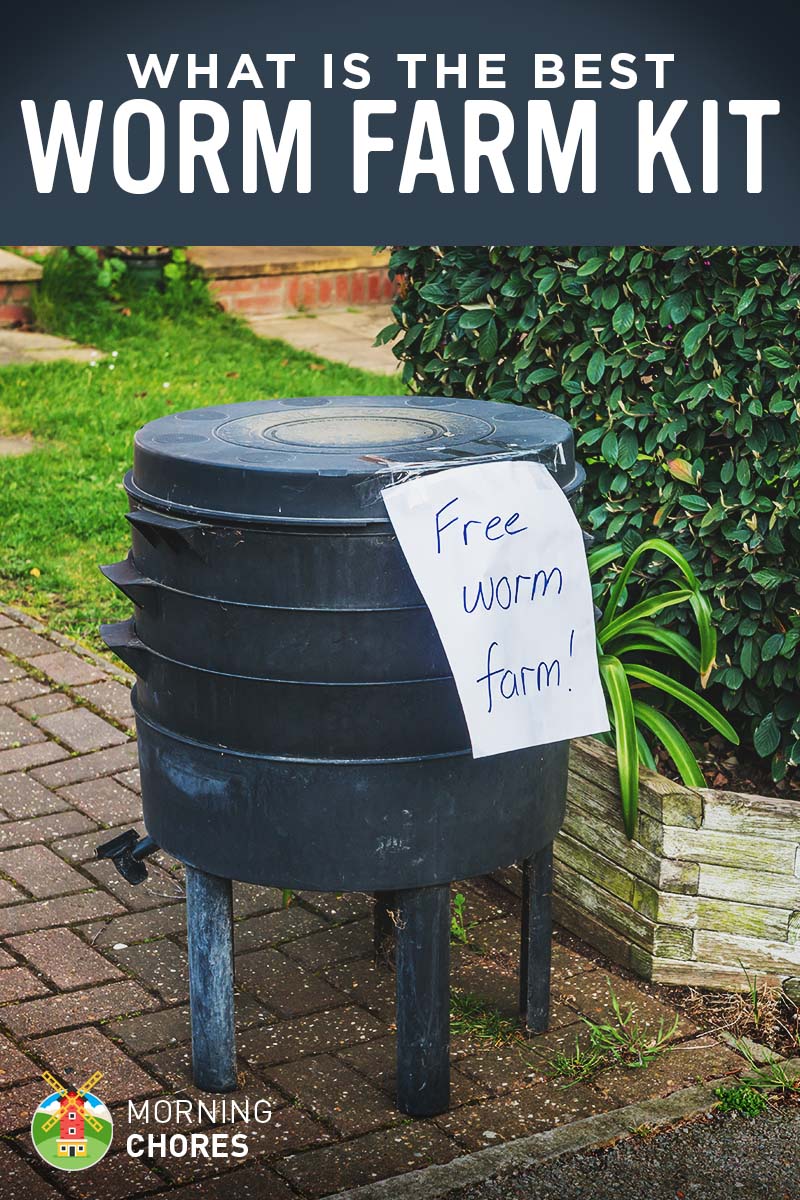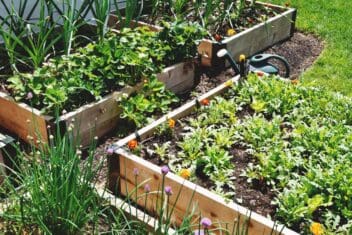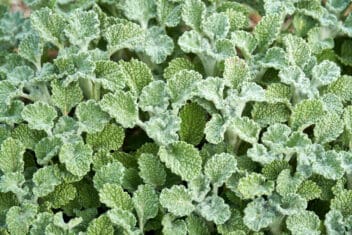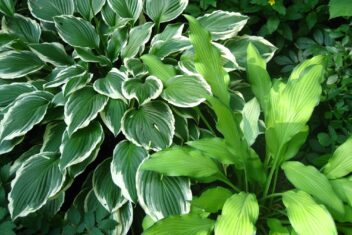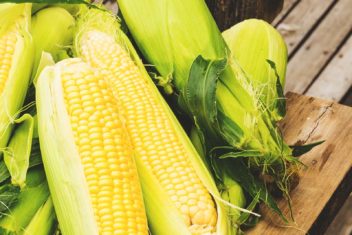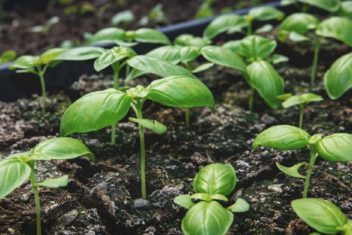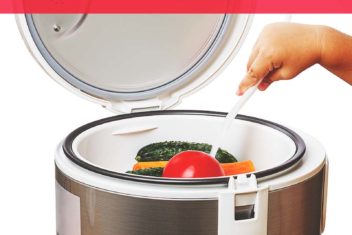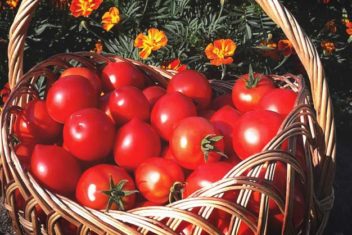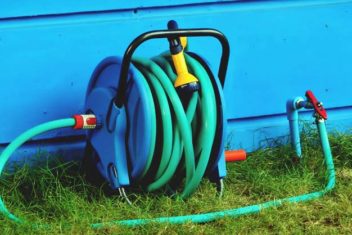Who knew that worms can be used for something other than fishing? Worms can be grown in a garden, for breaking down compost to produce soil nutrients.
You can actually purchase little ecosystems where they can live and reproduce teaching children about ecosystems, breaking down compost, and creating fertilizer that you can use in your garden.
If you are interested in raising worms yourself, here are a few worm farm reviews, and a helpful guide in choosing the right worm farm for your needs.
The 5 Best Worm Farm Kits
- The Squirm Firm Worm Factory 360 Composting Bin (Our Top Pick)
- Tumbleweed Can-O-Worms Vermicomposter
- Quest Worm Compost Kit
- HUNGRY BIN Worm Farm Compost Bin
- Maze Worm Farm Composter
Our Top Pick for the Best Worm Farm Kit
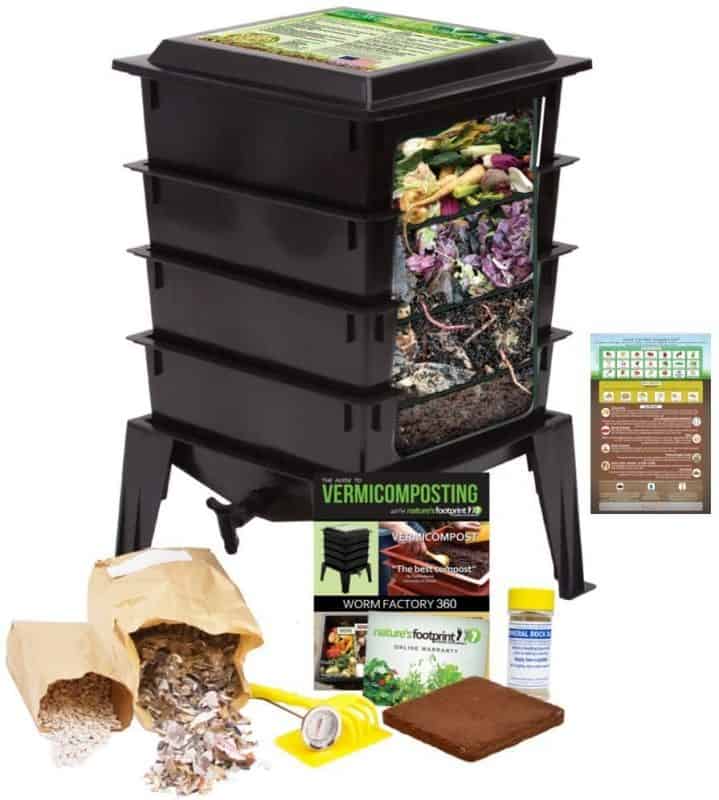
Our top pick for the best worm farm kit is The Squirm Firm Worm factory 360 Composting Bin.
The saying “if you pay peanuts, you get monkeys” doesn’t apply to this product. For its price, The Squirm Firm Worm Factory 360 Compost Bin is a well-designed product and it comes with everything you need to start breaking down composting straight away. The design also makes it very easy for you to manage the worm farm without any odors or leaks.
Check the price on AmazonWhat to Consider When Starting a Worm Farm
You will find that there are several types of worm farms out there, but how do you know which will be the right one for your home? Generally speaking, the larger the worm farm the better, as it can hold more worms. At full capacity, your average worm farm can hold up to 4,000 worms, and they can devour organic compost from a regular family of 4.
One feature that is important to have is an attached tap that will allow you to easily drain the worm farm periodically. Excess moisture will build up otherwise. The shape of the farm can also be an important consideration depending on where you want to store it, especially if it will be a year-round process.
Other than the farm itself, there are several more things to consider if this is the first time you’re raising worms.
Choosing a Worm Species
Certain worms are better suited for a worm farm than others, here is a list of worms that work well.
- Red worms (or red wigglers) – these are the best worms for composting. They tend to eat the same as other types of worms, but they breed faster and grow better in a worm farm environment.
- European nightcrawlers – these are the best to fish wish. If you are using your worm farm to grow fish bait, keep in mind that these worms are slow reproducers, but they do work well in a worm farm.
- Garden worms – if you plan on digging up your own worms from the garden, you will find that these worms do not work well in a worm farm, and they do not reproduce in that type of environment.
Preparing Your Worm Farm
Your worm farm will need to have the correct bedding to work properly. Your worm farm should provide this, if it doesn’t, shredded newspaper topped with food scraps will work. Some worm farms will come with a bedding block.
These need to be soaked in warm water before using, they can then be broken up and spread over the bottom tray of your worm farm. Ideally, start your worm farm with a minimum of 500 worms. They will need to be watered lightly, and a mat will need to be used to cover them creating false topsoil.
Maintaining Your Farm
It is very important to maintain your farm during the week. You need to keep the soil moist, and full of food scraps to make sure it will run correctly. It is important to flush out your topsoil once a week. You also need to keep the soil acidity down by adding a teaspoon of garden lime or worm farm soil conditioner once a week.
Make sure your farm is out of the sun, and in a shady spot to keep your worms from trying to escape. Always make sure to remember to add an additional tray with bedding and food above the tray your worms are currently occupying, so they have an opportunity to migrate upward.
If you want to read more about managing your worm farm, read this article on starting your own worm farm.
What You Will Get in a Worm Farm Kit
Worm farm, generally, is a compost bin. So when you’re purchasing a worm farm kit, you’re just buying a compost bin.
However, there are several types of compost bins, and not all of them are made for worms. Good worm farms come in trays. The trays make it easier for you to manage the farm. Also, if you want to expand the farm, you’d just add more trays instead of adding a whole new compost bin.
As mentioned above, a worm farm bin should also have a drain system.
Speaking of a worm farm kit, companies like to throw in different products as a package. This includes learning resources and live worms. It’s convenient, but sometimes the price becomes unnecessarily high because of the extra “bonus”. If you don’t want to pay a lot of money, you can just buy the farm/bin.
5 Best Worm Farm Kits – Reviews
1. The Squirm Firm Worm Factory 360 Composting Bin

The Squirm Firm Worm Factory 360 Composting Bin is a great composting solution that you can use all year long. Instead of using a large, smelly outside compost pile, this is a great alternative that is made of recycled plastic.
This kit comes with 4 stackable trays with screened bottoms, worm bedding materials, a base with an angled worm ladder, and a built-in spigot. It’s easy to get started; you just fill the bottom tray with bedding, food waste, and worms. As your worm colony grows, you can just add more trays.
The kit also includes a manual and an instructional DVD for easy setup and maintenance. It is easy to recycle scraps from your kitchen, paper, and cardboard into fertilizer you can use in your garden. Fertilizer created from worms has been reported to have nutrients that are 10 times greater than normally produced compost.
The Worm Factory 360 Composting Bin also does not require a lot of time to maintain. It only takes about 15 minutes each week. As the worms progress through the food, they migrate up into the next tray of scraps. Compost can be harvested monthly and used in your flower beds, vegetable garden, or even in your houseplants.
Features include a standard 4-tray size that can be expanded into 8 trays, and the handy redesigned lid changes into a stand when you are harvesting the compost.
The Squirm Firm kit also comes with a Quick Tips step-by-step guide to maintaining your worms, a “What Can Red Wigglers Eat?” infographic refrigerator magnet that provides information for worm food, and an accessory kit that includes a thermometer, hand rake, and a scraper.
Pros
- Takes up very little room, and is cleaner and easier to manage than other bin systems
- Well-made, and a great design
- Complete product with great instructions
Cons
- Expensive, unless you need the learning materials
- Some of the kits were delivered without the thermometer, rake, scraper, and DVD
2. Tumbleweed Can-O-Worms Vermicomposter
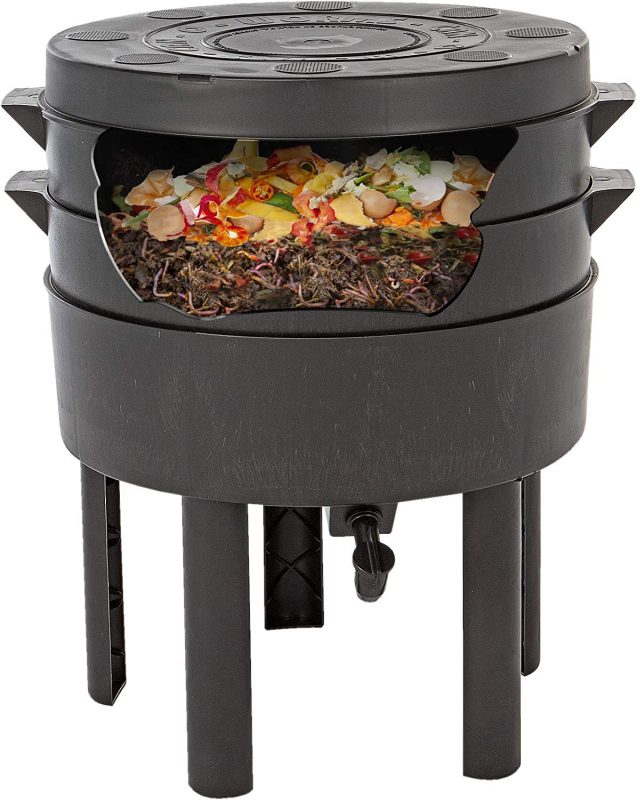
The Tumbleweed Can-O-Worms Vermicomposter makes recycling compost so easy which means it is perfect for the whole family. This compact composter bin can be used in your kitchen and will fit perfectly on a small patio.
It includes 2 large round trays, a flyproof ventilated lid, and a 4-legged base. The trays can be used for farming, while the ventilated collector tray holds the nutrient-rich compost tea. You can swap out the trays when you need to change out the food scrap layers, and the worms can migrate up to the next tray and work their decomposition magic.
The Tumbleweed worm composter is a great way to transform your food scraps, tea bags, and lawn clippings into useful compost for your garden. Its multi-layered design and drip-free tap allow for drainage and air circulation during the various stages of feeding, processing, and harvesting.
It comes with a colorful instruction manual that will make your setup fast and easy. Tumbleweed also includes a super-rich coir worm farm bedding block that expands up to 10 liters.
Although this worm composter bin can be used outdoors, the top plastic tray can blow off in the wind easily, so keep the bin in a sheltered spot.
Pros
- Very easy to separate the food from the worm castings
- Tray system is very easy to put together
- Built-in spigot and multiple layer design allows air and water to circulate
Cons
- Lid can blow off in the wind
- Plastic can buckle easily in high temperatures
- Tap has to be installed correctly to make sure that it doesn’t leak
3. Quest Worm Compost Kit
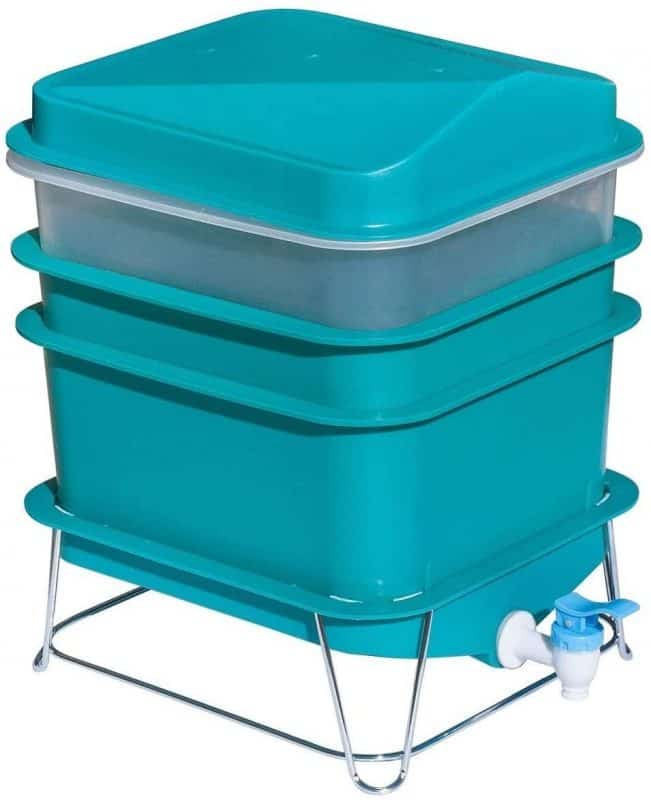
The best part about the Quest Worm Compost Kit is that it is not only practical for easy compost management but the bin looks great too. Its attractive green color will brighten up your deck, patio, or garden.
Besides, the Quest worm farm bin creates good ventilation and minimizes any odors so you can technically place it inside your kitchen if you want to. The design of this bin makes it a sturdy product and the base holder is made from strong wire.
It has 4 stackable working trays which automatically separate the casting and worms. The nutrient-rich compost tea collects in the bottom tray and the spigot allows for quick access to the tea.
You’ll also save money by using this worm farm to make your own homemade organic fertilizer.
Pros
- Beautifully designed, it looks great compared to some other products on this list
- Odorless, can even be placed indoors too
- Its design makes it easy to harvest castings
- Easy setup
- No liquid leaks and worms can’t get outside
Cons
- Product image provided can be misleading, especially the colors
4. HUNGRY BIN Worm Farm Compost Bin
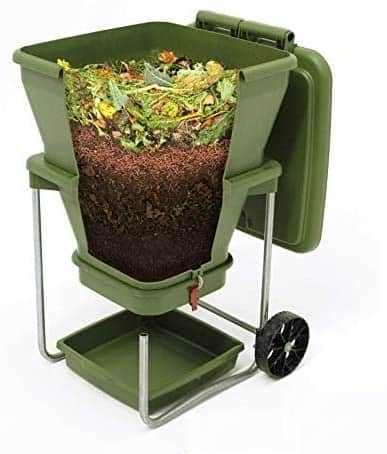
The HUNGRY BIN Worm Farm Compost Bin is a simple and easy way to compost your kitchen scraps. It has a patented and unique design that will effectively allow worms to compost organic waste, up to 4 pounds each day.
The waste is converted into natural fertilizers, including both castings and liquid that are nutrient-rich. The fertilizer is easy to collect from the sturdy HUNGRY BIN, which can be moved easily. It is best if used in a temperate climate, and should be placed in a position where there is no excessive heat or freezing weather conditions for an extended length of time.
It is a quick and convenient way to compost your kitchen scraps and has an innovative and patented design. Also, it is a highly efficient composter that allows worms to process up to 4 pounds of fertilizer per day. Organized waste is quickly converted into castings and nutrient-rich liquid.
Pros
- Very easy to add scraps and get the casting out
- Works great, and there is no smell and leaks
- Very easy to use, and looks nice
- Sturdy
Cons
- Not a tray system
- Expensive
5. Maze Worm Farm Composter
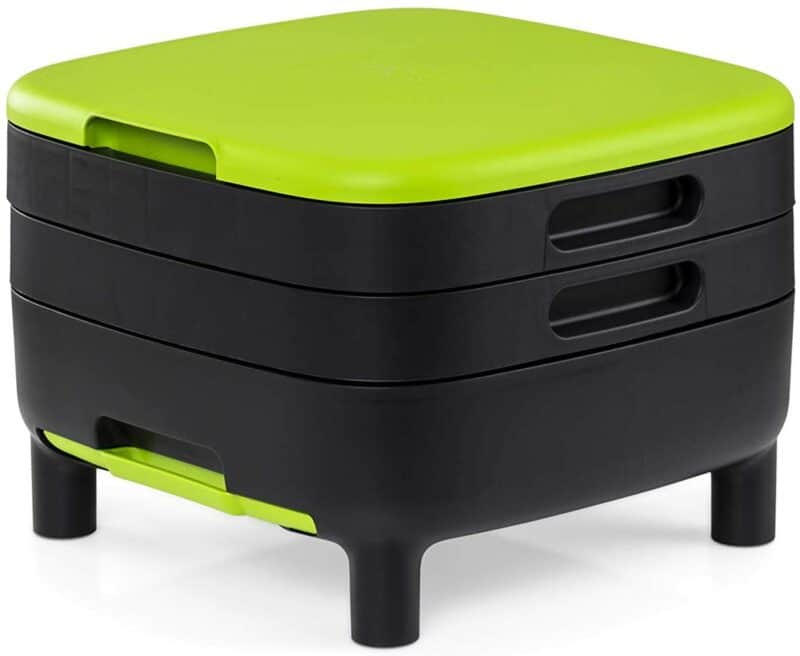
The Maze Worm Farm Composter makes it so easy to maintain a microbe-rich organic soil environment all year round. You can dispose of food scraps straight into the top tray and the bright green lid stops any flies from getting inside.
Once the rich compost tea is ready, slide out the bottom collection tray, and the compost can be emptied onto your indoor plants or a garden bed.
Its vertical design includes 2 rotatable trays, a sturdy base, and the open drain in the base allows for optimal aeration. The bright green worm saver tray stops the worms from falling into the bottom tray and it is very easy to clean.
Pros
- Vertical shelving design is ideal for the garden, patio, or balcony
- Very easy to use and clean
Cons
- Can get very heavy when full
- Pricey
Our Top Pick for the Best Worm Farm Kit

Our top pick for the best worm farm kit is The Squirm Firm Worm factory 360 Composting Bin.
The saying “if you pay peanuts, you get monkeys” doesn’t apply to this product. For its price, The Squirm Firm Worm Factory 360 Compost Bin is a well-designed product and it comes with everything you need to start breaking down composting straight away. The design also makes it very easy for you to manage the worm farm without any odors or leaks.
Check the price on Amazon